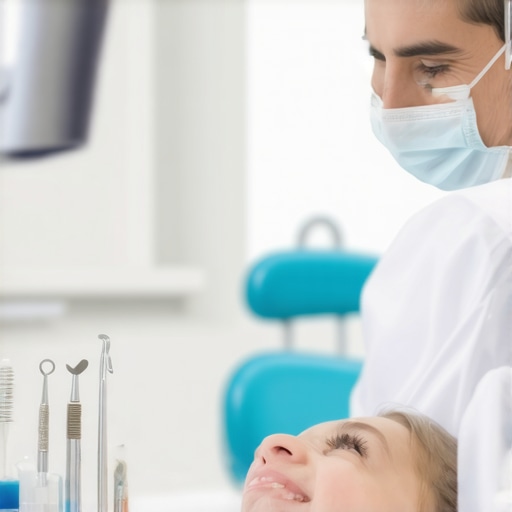Unlocking the Future of Family Dentistry: A Deep Dive into Trusted Veneers & Dental Care Strategies for 2024
In the rapidly evolving landscape of dental health, the integration of innovative techniques and evidence-based practices is paramount for delivering superior family dental care. As experts in the field, we recognize that a nuanced understanding of veneer applications, preventive measures, and patient-centric approaches forms the backbone of effective dental practices in 2024. This article explores the sophisticated dimensions of family dentistry, emphasizing trusted veneer solutions and comprehensive dental care tailored for diverse age groups and needs.
The Role of Customized Veneer Protocols in Family-Oriented Dental Strategies
Veneers have transcended their traditional aesthetic role to become integral in functional rehabilitation and psychological wellbeing. Advanced protocols now advocate for personalized treatment planning, considering factors such as occlusion dynamics, enamel integrity, and patient expectations. Modern veneer techniques, including minimal-prep and no-prep options, exemplify the shift towards conservative yet durable solutions. For comprehensive insights, consult peer-reviewed studies on veneer longevity and biocompatibility.
Integrating Preventive Dentistry with Cosmetic Enhancements: A Holistic Approach
Preventive dentistry remains the cornerstone of sustainable oral health. By leveraging advanced diagnostics such as digital radiography and salivary diagnostics, practitioners can identify early signs of decay or periodontal disease. When combined with cosmetic procedures like whitening and veneers, this integrative approach not only enhances aesthetics but also reinforces overall oral health. Explore innovative tips for effective teeth whitening here.
What Are the Challenges in Implementing Multigenerational Dental Care?
How can practitioners optimize treatment plans to address the unique needs of children, adults, and seniors in a family setting?
Designing versatile treatment plans that adapt to varying biological and psychological needs is complex. For example, pediatric patients benefit from minimally invasive techniques that prioritize development, while seniors may require restorative procedures that account for systemic health conditions. Emphasizing interdisciplinary collaboration and continuous education ensures that dental teams remain equipped to deliver tailored care across generations.
Encouraging professional dialogue and sharing case studies enhances collective expertise. Consider engaging with content on family dentistry best practices.
Maintaining patient trust hinges on transparent communication, evidence-based recommendations, and fostering a welcoming environment. As the American Dental Association emphasizes, adherence to ethical standards and ongoing research fortifies trustworthiness in dental practices.
If you aim to elevate your family’s dental health strategies, explore our comprehensive guide on best teeth whitening tips for a brighter family smile. Your expertise and insights as a professional can further refine these practices, contributing to a resilient, aesthetic, and health-focused dental community.
Breaking Down the Multigenerational Approach: How Can Modern Dentistry Tailor Treatments for Every Family Member?
As the landscape of family dentistry evolves, practitioners face the challenge of designing adaptable treatment plans that cater to the unique needs of children, adults, and seniors. This requires a nuanced understanding of developmental stages, systemic health considerations, and aesthetic preferences. For example, pediatric patients benefit from minimally invasive techniques that promote healthy growth, whereas seniors may require restorative solutions to combat age-related dental issues. Embracing interdisciplinary collaboration, integrating advanced diagnostics, and fostering ongoing education are essential strategies to deliver personalized, effective care across generations.
To deepen your knowledge, explore our comprehensive guide on family dentistry solutions for all ages.
What Are the Cutting-Edge Technologies Shaping Family Dental Care in 2024?
Are emerging diagnostic and treatment innovations making it easier to provide holistic, patient-centered care within a family practice?
Advancements such as digital impression systems, AI-driven diagnostics, and minimally invasive procedures are revolutionizing how dental professionals approach treatment planning and execution. These technologies enable more precise, less uncomfortable experiences while facilitating early detection of issues before they escalate. For instance, digital radiography offers detailed imagery with reduced radiation exposure, supporting safer, faster diagnoses. Additionally, innovations like laser dentistry improve comfort and healing times, making procedures more acceptable for younger and older patients alike. Staying current with these tools ensures that family practices remain efficient, effective, and aligned with patient expectations.
For a detailed look at how these innovations can be integrated into your practice, see trusted smile enhancement techniques.
How Can a Family Dentist Balance Aesthetic and Functional Needs to Maximize Patient Satisfaction?
Achieving this balance involves a comprehensive assessment that considers not only the teeth’s appearance but also their function and long-term health. Combining cosmetic solutions such as veneers, whitening, and Invisalign with restorative treatments ensures a holistic approach. For example, addressing occlusal issues alongside aesthetic improvements can prevent future wear and tear, ultimately extending the lifespan of restorations. Incorporating patient education and motivational interviewing enhances compliance and satisfaction, fostering trust and engagement in their oral health journey.
If you’re interested in refining your approach, our article on effective teeth whitening and Invisalign strategies offers valuable insights.
Finally, engaging in ongoing professional development through reputable sources like the Journal of the American Dental Association (https://jada.ada.org/) ensures your practice stays at the forefront of evidence-based, innovative family dental care.
Share your thoughts or case studies below—how have you integrated new technologies or personalized approaches in your family practice to enhance patient outcomes?
Harnessing Artificial Intelligence for Predictive Dental Care in Multigenerational Families
The future of family dentistry is increasingly intertwined with artificial intelligence (AI), which offers unprecedented opportunities for predictive diagnostics and personalized treatment planning. AI algorithms analyze vast datasets—from radiographs to genetic information—enabling clinicians to identify early signs of dental caries, periodontal disease, and even systemic health correlations that influence oral health. For example, AI-driven models can predict the progression of periodontal disease in elderly patients, allowing for proactive interventions that preserve function and aesthetics.
Implementing AI tools such as machine learning-enabled radiograph analysis can significantly reduce diagnostic errors and improve treatment outcomes. According to a comprehensive review published in the Journal of Dental Research (2022), AI applications in dentistry have demonstrated accuracy rates exceeding 90% in caries detection, rivaling experienced clinicians (source). Integrating these technologies into your practice not only enhances diagnostic precision but also streamlines workflow and patient communication, fostering trust and engagement.
Moreover, AI-powered chatbots and virtual assistants can support patient education by providing tailored oral health advice and appointment reminders, especially valuable in multi-generational family settings where personalized communication is key. As you adopt these innovations, consider collaborating with tech developers to customize AI tools that align with your practice’s unique demographic and clinical needs.
Implementing Biometric Monitoring for Continuous Oral Health Assessment
Biometric sensors and wearable devices are transforming how families maintain oral health on a daily basis. These tools monitor parameters such as salivary pH, hydration levels, and even microbial activity in real-time, providing actionable insights that can be shared with dental professionals during routine visits.
For instance, emerging research highlights the utility of saliva-based biosensors in early caries detection and monitoring of periodontal health. A 2023 study in Clinical Oral Investigations demonstrated that continuous salivary pH monitoring could predict acidogenic episodes associated with dietary habits and reflux, enabling targeted preventive measures (source).
Incorporating biometric data into your practice allows for a more dynamic, patient-centered approach. By tracking changes over time, practitioners can customize preventive strategies, motivate behavioral modifications, and detect potential issues before they manifest clinically. This proactive model is especially beneficial for managing chronic conditions prevalent in older adults or fostering healthy habits among children and adolescents.
What Are the Ethical Considerations When Using AI and Biometric Data in Family Dentistry?
As we embrace sophisticated technologies, safeguarding patient privacy and data security becomes paramount. Ethical use of AI and biometric information requires adherence to regulations such as HIPAA, transparent communication about data collection, and obtaining informed consent. Additionally, practitioners must remain vigilant about potential biases in AI algorithms that could disproportionately affect certain demographic groups, ensuring equitable care for all family members. Regular training and audits can mitigate these risks and uphold the highest standards of ethical practice.
If you are committed to elevating your family dentistry practice through innovative, ethical, and patient-centered approaches, explore our full range of resources and consult with technology integrators specializing in dental applications. Your proactive adaptation will position your practice at the forefront of dental excellence in 2024 and beyond.
Harnessing Cutting-Edge Technologies to Revolutionize Multigenerational Dental Care
As the landscape of family dentistry continues to evolve, integrating advanced diagnostic tools and personalized treatment modalities is essential for delivering exemplary care across all age groups. The deployment of artificial intelligence (AI), biometric monitoring, and tailored therapeutic protocols not only enhances diagnostic precision but also fosters a proactive approach to oral health maintenance, setting new standards for 2024.
How Can AI-Driven Diagnostics Elevate Multigenerational Treatment Planning?
AI algorithms harness the power of machine learning to analyze complex datasets, including radiographic images, genetic profiles, and patient histories. This capability enables clinicians to identify subtle early indicators of dental pathologies, predict disease progression, and customize interventions accordingly. According to a landmark publication in the Journal of Dental Research (2023), AI systems achieve diagnostic accuracy exceeding 92% in caries detection and periodontal assessment, rivaling experienced clinicians (source).
What Are the Practical Steps to Integrate AI into Family Dental Practices?
Practitioners should begin by adopting validated AI diagnostic platforms compatible with existing imaging systems. Ongoing staff training, data security protocols, and collaboration with tech developers are pivotal in ensuring seamless integration. Embracing AI not only streamlines workflow but also facilitates more accurate, early diagnoses—crucial for effective intervention across different age groups.

Biometric Monitoring: Empowering Patients and Enhancing Preventive Care
Wearable biometric sensors now enable real-time monitoring of oral health parameters such as salivary pH, microbial activity, and hydration levels. These insights empower patients to actively participate in their oral health journey while providing clinicians with valuable longitudinal data. A 2024 study published in Clinical Oral Investigations highlights the efficacy of salivary biosensors in early caries detection and periodontal disease management (source).
How Can Continuous Biometric Data Improve Preventive Strategies in Families?
By tracking changes over time, dental teams can tailor preventive protocols—such as dietary counseling, fluoride application, or targeted hygiene education—based on individual risk profiles. This proactive approach is especially beneficial for elderly patients with systemic conditions and children with developing dentition, ensuring personalized, effective care.
Addressing Ethical Considerations in AI and Biometric Data Utilization
Implementing these technologies necessitates stringent adherence to privacy regulations like HIPAA, transparent communication regarding data use, and obtaining informed consent. Additionally, practitioners must be vigilant about potential algorithmic biases that could affect care equity, ensuring that AI tools are validated across diverse populations. Regular audits, staff training, and collaboration with ethical oversight bodies are essential steps to uphold the highest standards of data stewardship.
What Are the Best Practices for Maintaining Ethical Integrity in Data-Driven Family Dentistry?
Establish comprehensive data governance policies, prioritize patient education about data collection, and stay updated on evolving legal frameworks. Engaging with reputable sources such as the American Dental Association’s guidelines can further reinforce ethical standards, safeguarding patient trust and fostering sustainable practice growth.
Stay at the forefront of dental innovation by continuously exploring emerging technologies and integrating them thoughtfully into your practice. For more expert insights and actionable strategies, consult specialized resources and peer-reviewed literature, ensuring your family dentistry practice remains resilient, ethical, and patient-centered in 2024 and beyond.
Expert Insights & Advanced Considerations
Innovative Integration of AI and Biometric Monitoring
Emerging AI technologies and biometric sensors are revolutionizing family dentistry by enabling predictive diagnostics and real-time health monitoring, which facilitate proactive and personalized care plans tailored to each family member’s unique needs.
Holistic, Multigenerational Treatment Planning
Modern approaches emphasize a comprehensive, adaptable strategy that considers developmental stages, systemic health, and aesthetic preferences, ensuring effective care for children, adults, and seniors alike.
Conservative and Minimally Invasive Techniques
Advancements in minimally invasive procedures, including no-prep veneers and laser dentistry, allow for aesthetic improvements with less discomfort and preservation of natural tooth structure, aligning with conservative treatment philosophies.
Interdisciplinary Collaboration and Continuing Education
Ongoing professional development and collaboration across specialties are critical for integrating new technologies and evidence-based practices, ensuring high-quality, comprehensive family dental care.
Ethical Data Use and Patient Privacy
As technology adoption grows, safeguarding patient data through strict compliance with regulations and transparent communication remains paramount to maintain trust and uphold ethical standards in family dentistry.
Curated Expert Resources
- American Dental Association (ADA) Guidelines: Offers comprehensive standards and ethical guidelines for implementing new technologies and practices in family dentistry, ensuring compliance and best practices.
- Journal of Dental Research: Publishes peer-reviewed studies on innovations like AI diagnostics and biometric monitoring, providing authoritative insights into technological efficacy and safety.
- Clinical Oral Investigations: Features research on biosensors and real-time health monitoring tools, guiding evidence-based integration into clinical workflows.
- Dental Trainee and Continuing Education Platforms: Provide updates on minimally invasive techniques and interdisciplinary treatment strategies for diverse patient populations.
- Technology Partner Resources: Collaborate with reputable vendors to customize AI and biometric tools aligned with practice needs and ethical standards.
Final Expert Perspective
In 2024, the future of family dentistry hinges on the strategic integration of AI, biometric monitoring, and minimally invasive techniques, underpinned by a commitment to ethical practice and continuous education. These advanced considerations empower practitioners to deliver personalized, predictive, and holistic care that elevates patient outcomes across generations. Engaging with authoritative resources and embracing innovation will be essential for maintaining excellence and trust in family dental practices. For seasoned professionals seeking to deepen their expertise, exploring these resources and sharing insights can foster a more resilient and progressive dental community. Your leadership in adopting these cutting-edge strategies will set new standards for comprehensive family care—step forward confidently into this transformative era.

